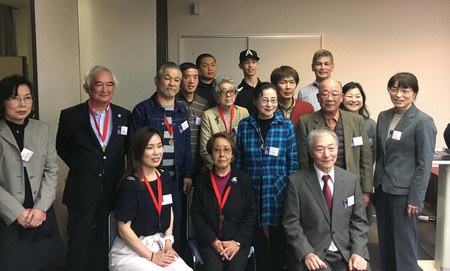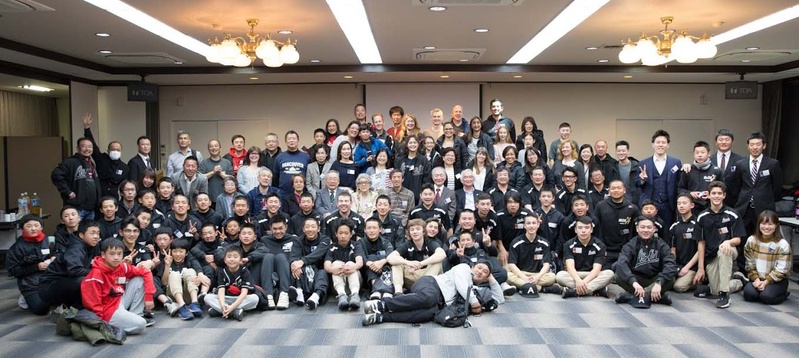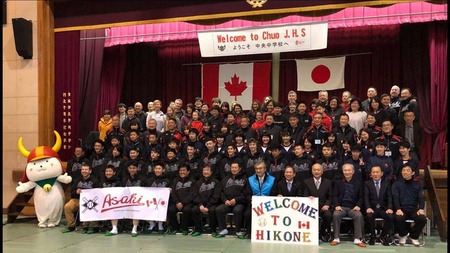At 4pm on March 20th, 2019, I was sitting on a bench in front of Hotel Comfort in front of JR Hikone Station, waiting for the bus coming from Yokohama. Two buses arrived right on time, and the energetic young players of the Vancouver Shin-Asahi youth baseball team and their parents got off with big smiles on their faces. I was greeted by John Wong, Tomio Fukumura and other officials of the visiting team, who greeted me and shook my hand.
"Welcome to Hikone! Thank you for your hard work."
The 55-member Shin Asahi delegation will be staying in Hikone for about a week, playing friendly matches with teams from Shiga Prefecture and participating in tourist activities.
The new Asahi team was formed in 2014, marking 100 years since the Vancouver Asahi was founded in 1914. The team toured Japan the following year in 2015, and has toured every two years since then, with this being their third visit to Japan.
The main purpose of this expedition was to visit Hikone, Shiga Prefecture, the birthplace of the Vancouver Asahi Shimbun, to learn about its history, and to play a friendly match with a Hikone baseball team.
In 1896, a large flood around Lake Biwa prompted many people from Hikone to leave for Canada, a new world. Many of them worked at sawmills and lived near Powell Street in Vancouver. When young children accompanied by their fathers and second-generation children born in Canada grew up and went to school, they became fascinated with baseball, which had recently been introduced from the United States, and even after graduating, they continued to get together to play baseball. Then, Hikone natives such as Miyazaki Ihachi, Tanabe Danzo, and Kishimoto Okura, who were like big brothers to the boys, coached and organized baseball teams. This was the formation of the Vancouver Asahi. The first manager was Miyazaki Ihachi, who was from Hikone, and Fukunaga Kinzaburo was the scorer. Naturally, many of the supporters and players were also from Hikone.
In 1918, my grandfather, Tojiro Matsumiya (a Hikone native), became head of the Vancouver Asahi team, changed the name to Asahi Athletic Club, recruited promising players from other teams to strengthen the team, and formed the International League in July 1918 to play in a league match against white teams. That year, the Asahi Athletic Club was runner-up, but the following year in 1919, they won the championship with an overwhelming record of 11 wins and 1 loss. In 2019, exactly 100 years after that, the new Asahi team came to Hikone.
I created a project team to welcome the Shin Asahi group, and we arranged for hotel accommodation and a baseball field, prepared for a friendly match, and raised funds for the activities. We held many meetings and made preparations to welcome them in Hikone so that their expedition would be as comfortable as possible and a success.
The next morning after we arrived, I went to the hotel to pick up the Shinasahi group. First, we paid a courtesy visit to the mayor of Hikone, and then we went to Hikone Chuo Junior High School to have a social event with the students. There were presentations from the students, and then a super carrom game was played, which instantly relaxed everyone at the venue. At the curry party for lunch, conversations flowed everywhere, making it a very meaningful social event.
In the afternoon, they moved to another location and played a match against the Hikone Little Senior team. Prior to the match, all the players lined up on the ground and a ceremony was held. After that, they moved on to calisthenics to loosen up their bodies, but the Shin Asahi players seemed a little confused. It is very interesting to see how the teaching methods differ depending on the country.
Before coming to Hikone, the Shinasahi team visited Vancouver's sister city of Yokohama and played two games. They defeated Yokohama Minami Little League 20-0 and Yokohama Izumi Little League 7-3, both of which were comfortable wins for Shinasahi.
The game finally started. In the first and second innings, both teams had hits, but no runs. In the top of the third inning, Hikone Little exploded with powerful hits and scored four runs. In the bottom of the inning, Shin Asahi scored one run, but was unable to gain any ground after that, and Hikone Little ended up winning 7-2, marking the first loss for Shin Asahi during this tour of Japan.
The next day, after practicing alone at Hikone Baseball Stadium, the team toured Hikone Castle and learned about the history of Hikone.
Next, on March 23rd and 24th, we played a friendly match against a little senior team from Shiga Prefecture at Asai Baseball Stadium in Nagahama City. The results were as follows:
March 23rd, first match: Koga Little Senior 11 vs Shin Asahi 6
Second game: Moriyama Little Senior 14 vs Shinasahi 1
March 24th First match: Kusatsu Little Senior 10 vs Shin Asahi 1
Second game: Shinasahi 5 vs Koto Little Senior 6
Although the Shinasahi team was unable to win in Hikone this time, the players learned a lot more than just winning or losing. Although there are differences between Japanese and Canadian baseball, I believe they gained a lot from the experience, such as sportsmanship, courtesy, the joy of baseball, and the exchange of hearts between young people that transcends language differences. I would also like to add that the Hikone Little Seniors supported the Shinasahi team during the four games at Asai Stadium, further strengthening the bond between the players and the team.
A welcome party for the new Asahi was held at the Hikone Labor Welfare Hall on March 23rd at 7pm. The hall was filled to capacity with over 120 attendees, including the new Asahi group, the Hikone Little Senior team, the mayor of Hikone, Asahi-related people, and local volunteers. Many people gave congratulatory speeches at the welcome party, and the party was covered by newspapers and EZ TV.
In his opening remarks, General Manager of the Expedition, Yoshinori Inomata, spoke about the significance and efforts of this expedition, and Shinasahi's captain, Blake, introduced each Shinasahi player. There was a sudden surprise from Hikone Little Senior. All the Hikone Little Senior players stood up, took off their T-shirts, and handed them to the Shinasahi players. The venue erupted in applause at this noble gesture, and the Shinasahi players were overjoyed to receive their uniforms.
And another strange coincidence was announced. In fact, the ancestor of Wylie Waters, a powerful hitter for the New Asahi, was Kenichi Doi, who played for the Original Asahi. Furthermore, the ancestor of Taiga Kitagawa of Hikone Little League was Sueyoshi Kodama, who also played for the Original Asahi. In fact, in the game on March 21, the Original Asahi and the current team were connected for over 100 years. During the game, we saw a scene where the first baseman, Wylie, made an out of a ball hit by Taiga Kitagawa.

After some time had passed, we all sang "Take Me Out to the Ball Game" together, took a commemorative photo, and then disbanded. Thank you to everyone who attended. Thank you very much.
Afterwards, the Shin Asahi group watched the National Baseball Championship at Koshien on March 25th, and then enjoyed sightseeing in Japan as a family before returning home.
I feel that this expedition of Shin Asahi to the Hikone area was a great success. The next expedition was scheduled for 2021, but it has already been postponed due to the impact of the COVID-19 pandemic, which is disappointing, but I hope to see you again soon.

* * * * *
"BBC (Biwako Broadcasting) broadcasts the exchange event with Hikone Chuo Junior High School"
"ZTV (Hikone Broadcasting Station) broadcasts the social gathering at the Labor Welfare Hall"
© 2020 Satoshi Matsumiya






